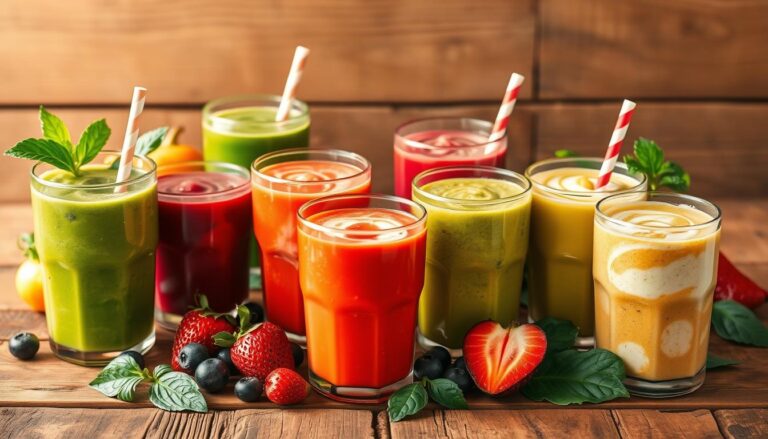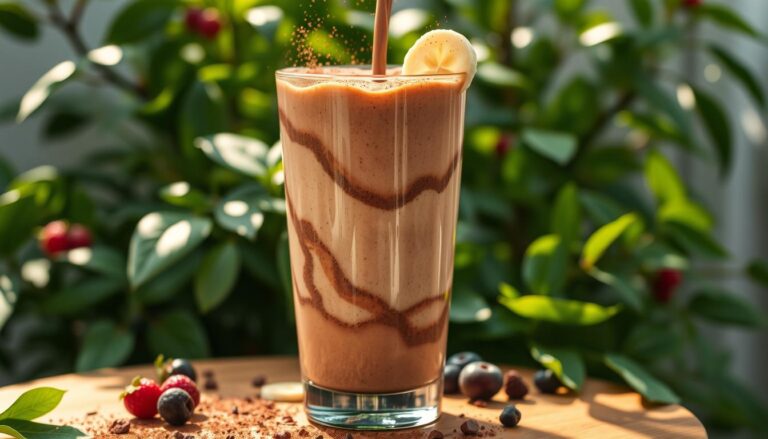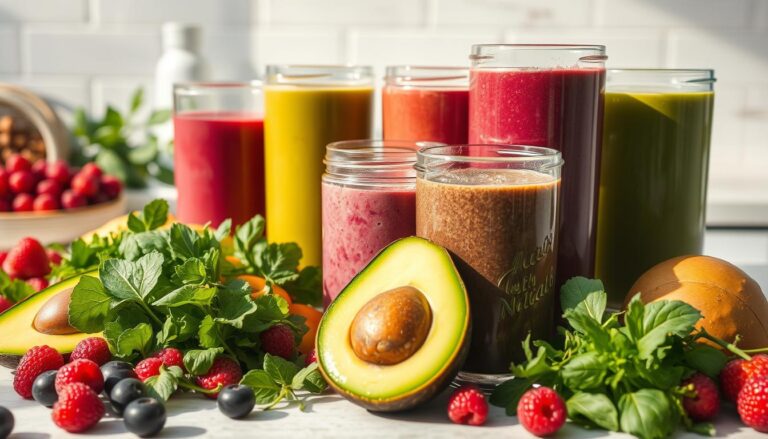Want a thick, plant-based drink that tastes like dessert but fuels your day? You can use frozen fruit for a creamy, ready-made base that stays nutrient-dense. Frozen blends often lock in flavor within 24 hours of harvest, so your drink can be both affordable and fresh.
Start by adding about 1 cup of liquid such as almond milk or water, then add frozen berries or mango. This order helps the blades move and prevents clumping. Use spinach, chia, or flax for added fiber without changing taste.
Whether you use a standard blender or a high-speed model like Vitamix, layering matters. Prep freezer packs for busy mornings and freeze leftovers for later. You’ll get a simple fruit smoothie recipe that fits vegan needs and busy schedules.
Ready to personalize your ideal blend? Try our smoothie generator and craft a recipe that matches your nutrition and flavor goals: https://healthconservatory.com/smoothie-generator
Key Takeaways
- Frozen fruit gives creamy texture and keeps nutrients fresh.
- Add liquid first—about 1 cup—then frozen ingredients for smooth blending.
- Plant-based milks like almond are great vegan choices.
- Spinach and seeds boost nutrition without strong taste.
- Prep freezer packs and use a high-speed blender for best results.
- Use the smoothie generator to customize flavor and nutrition.
How to Make a Smoothie with Frozen Fruit the Right Way
Frozen fruit gives your blend instant thickness and creaminess. Strawberries, blueberries, and mixed berry blends form a dense base because their water freezes into tiny crystals that break down into body during blending.
This means you need less liquid per cup of fruit, which preserves flavor and yields a spoonable, soft-serve texture. If your blender struggles, chop large frozen chunks like mango or pineapple before blending for faster results and fewer minutes on the blades.
Frozen produce is usually flash-frozen at peak ripeness, so nutrients and bright flavor lock in without additives. That preserved goodness keeps fiber intact, helping the drink feel more filling and nutritious.
- Thicker texture: frozen fruits beat fresh for body.
- Less liquid: start with a modest cup and add only if needed.
- Blender tip: powerful models blend faster; otherwise chop first.
- Flavor hack: mix tart berries with sweeter banana or mango for layered fruit flavor.
Your Vegan Smoothie Staples: Ingredients to Keep on Hand
Stock a few reliable frozen bags and plant-based milks so you can build tasty, nutrient-packed blends in minutes. Keep frozen strawberries, blueberries, mango, and a mixed berry blend for sweet, tart, and vibrant flavor profiles. These fruits cover most recipes and let you mix flavor combinations without extra shopping.
Round out your pantry with almond, oat, soy, cashew, and coconut milk so you can vary texture and taste. Almond adds a light nutty note, oat gives body, and coconut brings tropical richness. Label opened cartons with dates to keep milk fresh.
For dairy-free creaminess, keep coconut yogurt or almond yogurt on hand. They thicken blends and add tang without dairy. Toss in spinach for hidden greens and chia or flax seeds for fiber and protein that help you feel full.
- Core frozen fruit: strawberries, blueberries, mango, mixed berry blend.
- Plant milks: almond, oat, soy, cashew, coconut.
- Extras: coconut or almond yogurt, chia/flax seeds, hemp hearts, nut butters, and fresh fruit like banana.
Organize ingredients on one shelf so building a smoothie recipe becomes automatic. Rotate flavors weekly to keep your routine fresh and satisfying.
Order of Ingredients for the Creamiest Blend
Lay in your liquids first so the blades form a steady whirl that pulls everything down. This simple step helps any blender make a smooth, even mix without stalling.
Next add soft items like plant yogurt, ripe banana, or nut butter. These softer ingredients suspend in the liquid, creating body and richness.
Finish by topping with frozen fruit. For traditional blenders, this layering encourages a vortex that draws solids toward the blades.
Add liquid first, then soft ingredients, then frozen fruits
- Liquid first: pour about one cup of milk or water into the jar.
- Soft next: plant yogurt, fresh banana, or nut butter add creaminess.
- Frozen last: place frozen fruit on top so the blade path stays full and even.
When to adjust liquid vs. add ice
If the mixture is too thick to spin, pause and add small amounts of liquid rather than forcing the motor. If it’s too thin, add more frozen fruit instead of ice to protect sweetness and flavor.
| Problem | Quick fix | Why it works |
|---|---|---|
| Blender stalls | Add 2–4 tablespoons liquid | Creates a vortex and frees up the blades |
| Too thin | Add 1/4–1/2 cup frozen fruit | Thickens without diluting flavor |
| Not cold enough | Use a small handful of ice | Quick chill, but can dilute taste |
Step-by-Step: How to Make a Smoothie with Frozen Fruit
Make sure the base is secure, then pour roughly one cup of plant milk or water so the blades can form a strong vortex. This step helps the jar draw in solids and prevents the motor from stalling.
Next add soft items such as plant yogurt or a banana. Then pile frozen fruit like mixed berries or mango on top for body and chill.
Add a handful of spinach and a spoonful of seeds if you want extra nutrients that won’t change flavor.
Blend smart, then tweak
Start on low and increase to high. Blend for about 45–60 seconds until the texture is glossy and smooth.
- If the vortex stalls, stop and scrape the sides, then add a splash of milk or water.
- Adjust sweetness with naturally sweet fruit or a soft date before any added sugar.
- Use a couple of ice cubes only when frozen fruit isn’t fully frozen and you need extra chill.
Pour and enjoy immediately. This simple recipe approach fits any vegan pantry and works for most smoothie recipe swaps using fresh fruit, different milks, or protein add-ins.
Best Frozen Fruits for Vegan Smoothies
Choose pairings that balance taste and texture. Combining tart and creamy options gives you natural sweetness without added sugar. Frozen fruit delivers consistent thickness and flavor year-round.
Berry favorites
Strawberries, blueberries, raspberries, blackberries
Lean on strawberries and blueberries for a classic berry smoothie. Add raspberries or blackberries for deeper color and a bright tart note.
Creamy options
Banana, mango, peaches, cherries
Use bananas or mango for lush body that mimics dairy. Peaches and cherries add softness and subtle sweetness that blends smoothly with berries.
Tropical tang
Pineapple and passion fruit
Pineapple and passion fruit add lively acid and tropical lift. Pair them with plant milk for richer mouthfeel or with mixed berry packs for contrast.
| Use | Best picks | Why |
|---|---|---|
| Classic berry blend | Strawberries, blueberries, mixed berry | Bright flavor, great color, works with any milk |
| Extra creaminess | Bananas, mango, peaches | Thickens without dairy and keeps you full |
| Tropical boost | Pineapple, passion fruit | Adds tang and lifts sweet fruits |
- Keep a mixed berry bag for quick blends with plant milk.
- Combine fresh fruit with frozen fruits to avoid ice and keep thickness.
- Pulse gently first if your blender struggles, then increase speed.
Choose Your Liquid Wisely to Add Flavor and Fiber
Your base liquid decides whether the drink is light and sippable or thick and spoonable. For a vegan cup that still feels indulgent, start with unsweetened plant milk or water and tweak from there.
Almond milk gives a light, neutral base that lets fruit shine and keeps saturated fat low. Oat milk adds body and a naturally creamy mouthfeel, which helps when you want spoonable texture without extra ingredients.
Coconut milk brings richness and a subtle tropical note—great with mango or pineapple. If you’ve used cow milk before, oat or soy replace body while keeping the recipe fully plant-based.
Water keeps calories down and highlights fruit, but may require more frozen fruit for thickness. Juice brightens flavor fast, yet raises sugar; use only a splash and balance with fiber-rich berries, seeds, or oats.
- Start with about one cup of liquid and add more in small amounts.
- For fiber-forward blends, pair oat milk with berries and flax for steady energy.
- Post-workout option: coconut water adds electrolytes without heavy calories.
Nutritious Add-Ins: Protein, Fiber, and Healthy Fats
Small, nutrient-dense add-ins can transform a basic blend into a balanced meal. Pick vegan options that mix easily and keep flavor true to the fruit.
Plant protein boosts
Use pea or soy protein powder for a quick protein lift that dissolves smoothly. Hemp seeds work well as a whole-food option if you prefer less processed choices.
Fiber boosters that help satiety
Stir in chia or ground flax to add fiber and omega-3s. Rolled oats also thicken the texture and provide soluble fiber for steady energy.
Greens that blend in
A handful of spinach or a few kale leaves mixes without strong taste. These greens raise vitamin and mineral content while staying subtle in flavor.
Flavor and healthy fat
Add cinnamon, vanilla, or cocoa for depth without sugar. A spoonful of coconut or almond yogurt adds body while keeping saturated fat modest. Nut or seed butters supply healthy fat and a toasty note.
- Layer add-ins under frozen fruit so they incorporate evenly.
- Start small with powders and spices, then adjust after tasting.
- Rotate ingredients across the week for variety and balanced nutrition in every smoothie.
Dialing In Texture, Flavor, and Sweetness

Dial in texture by adding small amounts of liquid until the jar pours the way you want. Start with a splash, blend briefly, then add more if it still clogs. This prevents over-thinning and keeps the body you get from frozen fruit.
Thick vs. sippable: how much liquid to add
For a spoonable cup, use extra frozen fruit and minimal liquid. For a drinkable pour, add plant milk a little at a time until it flows.
Blend in short bursts—run the motor for a few seconds, check consistency, then pulse again. This saves blender wear and avoids turning a thick blend into a watery one.
Naturally sweet options without added sugar
Use ripe banana, mango, or a pitted date to raise sweetness naturally. These choices preserve bright flavor without granulated sugar.
- Less ice: favor frozen fruit over ice so flavor stays concentrated.
- Short minutes: pulse in 10–20 second intervals between checks.
- Fat matters: a spoon of nut butter or plant yogurt rounds mouthfeel and balance.
- Taste and tweak: a tiny pinch of salt can lift fruit flavor without making it salty.
- Serve in a chilled glass if you want a thinner, cold drink without extra ice.
Equipment Tips: Getting the Most from Your Blender
Keep liquids chilled and add them first so the blades form a steady vortex that pulls ingredients down. This simple step helps any machine move frozen packs without stalling. For best results, layer liquid, soft add-ins, then frozen pieces.
High-speed vs. standard models
High-speed blenders like Vitamix need less liquid and finish in far fewer minutes. They create a smoother puree and handle large chunks easily.
Standard blenders work if you cut big pieces small, pulse first, then blend on high. Let very hard pieces thaw 5–10 minutes when needed.
- Minimize ice — frozen fruit and plant yogurt give thickness without dilution.
- If blades cavitate, stop, scrape, and add a splash of liquid.
- Add a little protein powder or oats for texture stability after pouring.
- Swap cow milk habits with oat or soy plus banana for similar body in this vegan recipe.
- Clean the jar immediately: warm water, soap, and a quick blend cycle saves time.
Smart Prep: Freezer Packs and Make-Ahead Tricks
Prep weekend packs of portioned fruit and greens so busy mornings take only moments. Build quart-size bags with measured mixes that snap into your routine. This saves time and reduces waste while keeping flavor fresh.
Assemble packs for quick mornings
Portioning is simple: add a handful of mixed fruits, a small handful of greens, and a spoon of seeds into each bag. Flatten and label each pack so it stacks neatly and thaws a few minutes faster when needed.
- Pour about one cup of plant milk or water into the blender first.
- Add a frozen fruit pack and any frozen banana slices, then blend until smooth.
- Freeze ripe banana slices ahead; they cut waste and give creamy body.
Storing leftovers and safe thawing
If you make extras, pour into single-serve jars and freeze. Thaw on the counter until drinkable, then give a quick re-blend with a splash of liquid if separation occurs.
Plan for the week: prepare three to five packs on the weekend. Rotate fruits so flavors stay interesting, and add small note cards with suggestions like “use oat milk” or “add cinnamon” for fast variety.
Try These Vegan Flavor Combos for Your Next Fruit Smoothie
Pick one of these simple vegan combos for an easy, nutrient-forward breakfast or snack. Each pairing keeps ingredients common and the steps repeatable so your fruit smoothie recipe stays reliable.
Mixed berry + spinach + almond milk + chia
Blend frozen mixed berry with a handful of spinach, unsweetened almond milk, and chia seeds for fiber and omega-3s.
For more depth, add extra strawberries and blueberries. This amps color and tang without extra sugar.
Mango + pineapple + coconut milk + flax
Create a tropical, dessert-like cup by pairing mango and pineapple with creamy coconut milk and ground flax for a silky finish.
Strawberry + peach + oat milk + hemp protein
This gentle mix stays naturally sweet and provides plant protein for lasting fullness. Add half a banana when you want more creaminess.
- Use vanilla protein powder or cocoa powder to tailor taste and nutrition.
- Balance tart fruit with creamy bases and neutral greens like spinach for steady flavor.
- For a thicker bowl, cut milk and top with sliced fruit plus extra chia seeds.
- Keep portions steady with the same measuring cup and rotate these smoothie recipe ideas through the week.
Conclusion
You now have a simple recipe for reliable morning blends. Use clear ratios, keep add-ins handy, and blend in short bursts for the texture you want.
Frozen fruit, plant milks, and small add-ins give consistent nutrition and flavor. These staples make smoothies that suit breakfast, snacks, or post-workout boosts. Adjust liquid in small splashes and taste as you go for the best result.
Keep freezer packs for fast prep and choose your base and mix-ins by personal preference. Ready for tailored ideas? Use our smoothie generator for custom plans and shopping lists: https://healthconservatory.com/smoothie-generator




